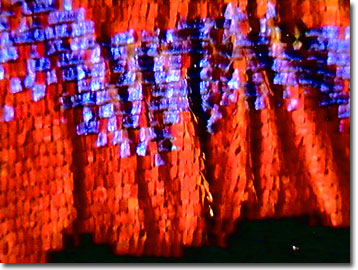Butterfly Wing Scale Digital Image Gallery
Chinese Peacock Butterfly
Similar to its avian namesake, the male Chinese peacock butterfly is the more glamorous of the two sexes. Although slightly smaller than female peacock butterflies, males of the species are curiously striking. Sometimes simply appearing deep black, in certain light their wings glow with iridescent green, blue, violet, yellow, and red hues.

The Chinese peacock butterfly is found in areas ranging from southeastern China to South Korea, including Japan, Sakhalin, and the Kuril Islands. There are seasonal and geographical variations observed throughout its range, which account for a total of eleven subspecies. Scientifically described as Papilio bianor, the Chinese peacock butterfly has more than one common name. In Japan, where it is cherished for its flashy colors and large size, the species is better known as karasuageha, named after the iridescent wing feathers of the crow, or karasu.
One of the characteristics that makes Chinese peacock butterflies so beautiful also increases their probability of survival. Frogs, lizards, mantises, dragonflies, and birds like to feed upon adult Chinese peacocks and may attack individuals or groups congregated at puddles or nectar sources. As the butterflies quickly disperse, the distinctive trailing tails on their hind wings may cause confusion. Often predators will attack the showy tails, rather than the vital head and thorax regions. Although they may be not as aesthetically pleasing after such an attack, they can carry on life functions.
Chinese peacock caterpillars are not as colorful as the adults, but are unusually sociable. The young larvae of the Chinese peacock butterfly have black heads and brown bodies covered in white hairs. As the caterpillars grow, they transform into a white-spotted light green. No matter what stage they are in, the gregarious larvae do not like to be alone. Instead, they prefer to feed and sleep together in large groups and, when a host plant is stripped bare, they disperse en masse to another suitable plant. The group remains together even after the larval stage is complete by pupating in the same tree.
Contributing Authors
Cynthia D. Kelly, Shannon H. Neaves, Laurence D. Zuckerman, and Michael W. Davidson - National High Magnetic Field Laboratory, 1800 East Paul Dirac Dr., The Florida State University, Tallahassee, Florida, 32310.
BACK TO THE BUTTERFLY WING SCALE IMAGE GALLERY
BACK TO THE DIGITAL IMAGE GALLERIES
Questions or comments? Send us an email.
© 1995-2025 by Michael W. Davidson and The Florida State University. All Rights Reserved. No images, graphics, software, scripts, or applets may be reproduced or used in any manner without permission from the copyright holders. Use of this website means you agree to all of the Legal Terms and Conditions set forth by the owners.
This website is maintained by our
Graphics & Web Programming Team
in collaboration with Optical Microscopy at the
National High Magnetic Field Laboratory.
Last Modification Friday, Nov 13, 2015 at 01:19 PM
Access Count Since January 21, 2003: 10530
Visit the website of our partner in introductory microscopy education:
|
|
